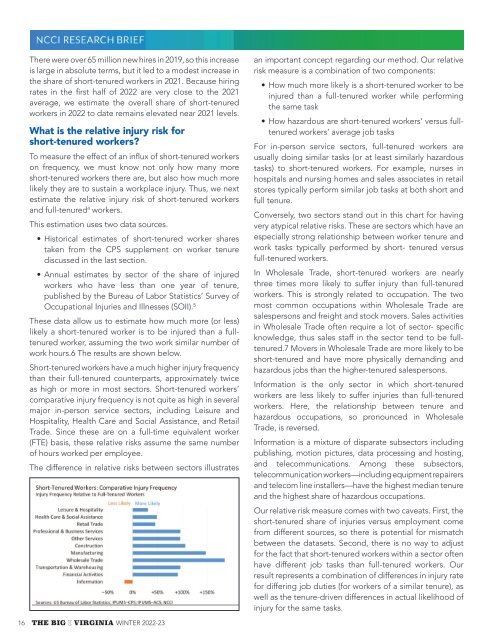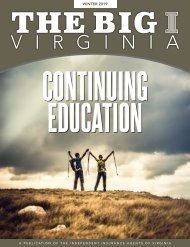The Big I Virginia Winter 2022-23
Create successful ePaper yourself
Turn your PDF publications into a flip-book with our unique Google optimized e-Paper software.
<strong>The</strong>re were over 65 million new hires in 2019, so this increase an important concept regarding our method. Our relative<br />
is large<br />
Introduction<br />
in absolute terms, but it led to a modest increase in risk measure is a combination of two components:<br />
the share of short-tenured workers in 2021. Because hiring<br />
<strong>The</strong> Great Reshuffle is reshaping the US labor market. Unemployment • How much more is historically likely a short-tenured low, but labor worker force to be<br />
rates in the first half of <strong>2022</strong> are very close to the 2021<br />
average, participation we estimate is still the lower overall than share the pre-pandemic of short-tenured rate. Labor injured shortages than have a full-tenured led to wage worker growth, while especially performing<br />
the same task<br />
workers strong in <strong>2022</strong> among to date low-wage remains workers elevated and near in sectors 2021 levels. like Leisure and Hospitality.<br />
• How hazardous are short-tenured workers’ versus fulltenured<br />
the time workers’ of this average writing—about job tasks 50 million quits a<br />
What Quit is rates the jumped relative in injury the middle risk of for 2021 and remain high at<br />
short-tenured year, almost 10 workers? million more than pre-pandemic averages. For Many in-person workers service are sectors, new to their full-tenured jobs. Some workers of these are<br />
To measure are moving the effect from one of an similar influx of job short-tenured to another, workers but others usually are changing doing similar industries tasks or (or occupations. least similarly At the hazardous same<br />
on time, frequency, there we are must a large know number not only of new how remote many more workers. tasks) Many to people short-tenured left the office workers. at COVID’s For example, onset; nurses there in has<br />
short-tenured been a trickle workers back, there representing are, but also a massive how much change more in the hospitals amount and of nursing remote homes work compared and sales associates to before in the retail<br />
likely they are to sustain a workplace injury. Thus, we next stores typically perform similar job tasks at both short and<br />
pandemic.<br />
estimate the relative injury risk of short-tenured workers full tenure.<br />
and How full-tenured do such 4 workers. large changes in the labor market impact Conversely, workers compensation two sectors stand injury out frequency? in this chart <strong>The</strong> for magnitude having<br />
This of estimation these impacts uses two relies data on sources. the interaction of three factors: very atypical relative risks. <strong>The</strong>se are sectors which have an<br />
• Historical estimates of short-tenured worker shares especially strong relationship between worker tenure and<br />
taken • from How the much CPS more supplement or less likely on worker are short-tenured tenure work remote tasks typically workers performed to be injured by short- than other tenured workers? versus<br />
discussed • How in the much last has section. the share of such workers changed? full-tenured workers.<br />
• Annual • How estimates has the by sector mix of the of the share workforce of injured changed In Wholesale during the Trade, pandemic? short-tenured workers are nearly<br />
workers who have less than one year of tenure,<br />
published by the Bureau of Labor Statistics’ Survey of<br />
Occupational Injuries and Illnesses (SOII). 5<br />
<strong>The</strong>se data allow us to estimate how much more (or less)<br />
likely a short-tenured worker is to be injured than a fulltenured<br />
worker, assuming the two work similar number of<br />
work hours.6 <strong>The</strong> results are shown below.<br />
Short-tenured workers have a much higher injury frequency<br />
than their full-tenured counterparts, approximately twice<br />
as high or more in most sectors. Short-tenured workers’<br />
comparative injury frequency is not quite as high in several<br />
major in-person service sectors, including Leisure and<br />
Hospitality, Health Care and Social Assistance, and Retail<br />
Trade. Since these are on a full-time equivalent worker<br />
(FTE) basis, these relative risks assume the same number<br />
of hours worked per employee.<br />
<strong>The</strong> difference in relative risks between sectors illustrates<br />
16 THE BIG I VIRGINIA WINTER <strong>2022</strong>-<strong>23</strong><br />
three times more likely to suffer injury than full-tenured<br />
workers. This is strongly related to occupation. <strong>The</strong> two<br />
most common occupations within Wholesale Trade are<br />
salespersons and freight and stock movers. Sales activities<br />
in Wholesale Trade often require a lot of sector- specific<br />
knowledge, thus sales staff in the sector tend to be fulltenured.7<br />
Movers in Wholesale Trade are more likely to be<br />
short-tenured and have more physically demanding and<br />
hazardous jobs than the higher-tenured salespersons.<br />
Information is the only sector in which short-tenured<br />
workers are less likely to suffer injuries than full-tenured<br />
workers. Here, the relationship between tenure and<br />
hazardous occupations, so pronounced in Wholesale<br />
Trade, is reversed.<br />
Information is a mixture of disparate subsectors including<br />
publishing, motion pictures, data processing and hosting,<br />
and telecommunications. Among these subsectors,<br />
telecommunication workers—including equipment repairers<br />
and telecom line installers—have the highest median tenure<br />
and the highest share of hazardous occupations.<br />
Our relative risk measure comes with two caveats. First, the<br />
short-tenured share of injuries versus employment come<br />
from different sources, so there is potential for mismatch<br />
between the datasets. Second, there is no way to adjust<br />
for the fact that short-tenured workers within a sector often<br />
have different job tasks than full-tenured workers. Our<br />
result represents a combination of differences in injury rate<br />
for differing job duties (for workers of a similar tenure), as<br />
well as the tenure-driven differences in actual likelihood of<br />
injury for the same tasks.

















